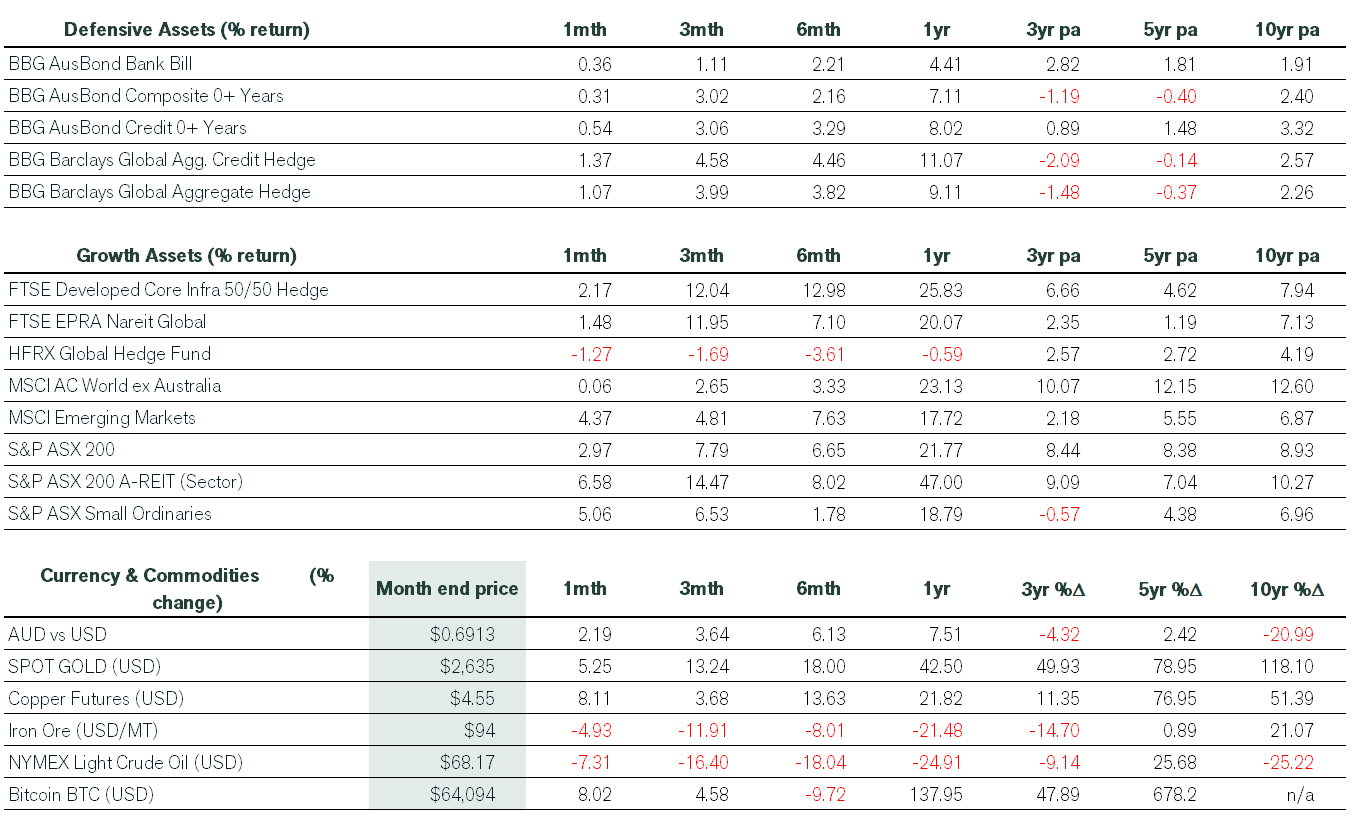October 2024 Economic & Market Review – Mixed Outcomes Across the Board
Talking points
- October’s Market: Mixed Outcomes Across the Board: October was a turbulent month for investors as rising bond yields put pressure on the share market, while the US dollar climbed amid speculation on political shifts. Rising tariffs and tax cut proposals from Trump’s potential return stirred inflation concerns, raising doubts about future rate cuts.
- Global Markets: Currency Shifts and Mixed Returns: Global stocks saw mixed outcomes. The MSCI ACWI ex-Australia index dropped 1.1% in October, yet Australian investors reaped a 3.7% gain due to a weaker Aussie dollar. In the US, markets were varied: the S&P 500 and Nasdaq faced slight declines, while the Dow maintained its year-to-date strength. Emerging markets felt the strain, though gains were made in Australian dollar terms.
- Domestic Market and Property Sector: Yield Surge Pressures ASX: In Australia, the ASX 200 closed down 1.3% in October as bond yield increases affected both domestic and international property sectors. However, domestic property stocks still boast a strong 50% return over the past year, showcasing resilience amid rising yield challenges.
- Bond and Credit Markets: Rising Yields Amid Rate Cuts: Despite rate cuts by the US Fed and the European Central Bank (ECB), bond yields surged globally. The US 10-year Treasury rose to 4.28%, while Australia’s 10-year yield hit 4.51%, marking an October high. In credit, European high-yield bonds performed well, benefitting from the ECB’s easing stance.
- Economic Highlights: Shifting Inflation and Consumer Trends: Inflation showed signs of cooling in Australia with CPI slowing to 2.8%, yet core inflation remained above forecast, keeping the Reserve Bank of Australia watchful. Globally, US consumer prices inched up, while Europe saw a surprise inflation uptick. Rising food prices continued to push consumers toward budget-friendly options, a trend consistent in both the US and Australia.
Market commentary
October was a mixed bag for investors as a surge in bond yields weighed on sharemarket returns and pushed fixed interest markets back into the red. A rising US dollar accompanied the spike in bond yields as investors began to bet that a second Trump presidency would be the likely outcome of a close election battle. Trump’s high tariff and corporate tax cut proposals were seen as more likely to restoke inflationary pressures and prevent meaningful cuts in official interest rates in 2025.
In local currency terms, the MSCI ACWI ex-Australia index lost 1.1% in October, including dividends. However, a sharp depreciation in the Australian dollar resulted in a healthy 3.7% return to unhedged domestic investors. The S&P 500 fell 1% in October despite what was seen by analysts as solid second quarter company earnings results. This took the S&P 500 YTD return to 19.6%. The Dow Jones Industrial Average declined 1.3% in the month but is up 26.4% in 2024. Meanwhile, the Nasdaq 100 lost 0.9%, taking its YTD return to 18.2%. The weak October for the Nasdaq followed its first positive September since 2019.
Similarly, emerging market equities lost 2.8% in local currency terms, but this translated to a 1.3% gain in Australian dollars—continuing the momentum gained following the China stimulus announcements in the prior month. Indian stocks had a disappointing October as weak corporate results drove investors away from risk assets.
On the domestic front, the ASX 200 finished the month 1.3% lower. Meanwhile, rising yields impacted returns in domestic and global listed property stocks. Notably, domestic listed property has now returned more than 50% over the last twelve months.
In fixed interest, global bond yields were generally higher, despite the US Fed cutting interest rates in September and guiding for further policy easing over the coming months. The US 10-year Treasury note finished the month 56 basis points above its low point for the month at 4.28%. Not to be outdone, the 10-year Commonwealth Government Bond yield surged to 4.51% by month’s end, after trading as low as 3.92% at the beginning of October. In credit markets, European high-yield bonds performed strongly, with investors reacting favourably to the ECB’s interest rate easing cycle.
Elsewhere, global oil markets experienced higher than average levels of volatility in October, ultimately posting a small gain in US dollar terms, as investors weighed the potential for a further escalation in tensions in the Middle East. Gold benefited from the heightened uncertainty emanating from a range of factors, including geopolitical machinations, the US presidential election outcome and the risk of a spike in inflation, to name a few.
The increase in financial market volatility proved beneficial for hedge funds, where global returns jumped 5.2%, though the asset class lags cash over the last twelve months.
Economic commentary
Australia
In Australia, the labour market continued to boom, and the unemployment rate remained at 4.1% despite a massive increase in workforce participation. Employment grew by 64,100 in September, and there were 9,200 fewer unemployed people. The main focus during the month was the September quarter CPI figures that showed the annual pace of inflation slowed to 2.8% from 3.8% in the previous quarter due to electricity bill rebates and lower fuel prices. Electricity bills fell 17.3% over the quarter as households received their first quarterly instalment of a $300 federal government energy rebate, as well as generous state-level grants. Yet, core inflation – the RBA’s preferred measure – gained 0.8% quarter-on-quarter, which was above forecasts for a 0.7% increase. Annually, the measure cooled to 3.5%, in line with expectations.
Global
On the economic front, US consumer prices (as measured by the CPI) rose 2.4% in the year to September, a three-year low, though that pace was higher than the 2.3% economists had expected. Overall, inflation was held down by a significant decline in fuel prices, which fell 4.1% month over month. Core inflation rose 3.3% in the year to September, again higher than expected. Notably, food prices have jumped nearly 25% from pre-pandemic levels, well beyond the pace of wage growth. In response to higher food prices, many consumers have shifted their spending from name brands to private labels and are shopping more at discount stores. A similar theme is emerging in Australia.
Meanwhile, in Europe, the ECB lowered its three key interest rates by 0.25% in October, as expected, following similar moves in September and June. However, data released over the following weeks showed that annual inflation accelerated to 2% in October, above expectations and up from 1.7% in September (which was the lowest level since April 2021). Food prices drove the surprise strength in the data. On a more positive note, annual services inflation steadied at 3.9%. Meanwhile, annual core inflation was unchanged at 2.7%, the lowest read since February 2022, but slightly above consensus forecasts. Finally, Eurozone GDP expanded 0.4% in the September quarter, the strongest growth rate in two years and well above expectations. The ECB expects Eurozone GDP to expand 0.8% this year.
Get in touch to discuss your personal investment strategy
If you want to discuss any of the above information or your personal investment strategy, then book a chat with your financial adviser here.
Pete is the Co-Founder, Principal Adviser and oversees the investment committee for Pekada. He has over 18 years of experience as a financial planner. Based in Melbourne, Pete is on a mission to help everyday Australians achieve financial independence and the lifestyle they dream of. Pete has been featured in Australian Financial Review, Money Magazine, Super Guide, Domain, American Express and Nest Egg. His qualifications include a Masters of Commerce (Financial Planning), SMSF Association SMSF Specialist Advisor™ (SSA) and Certified Investment Management Analyst® (CIMA®).


